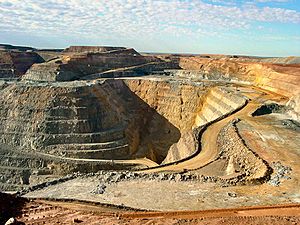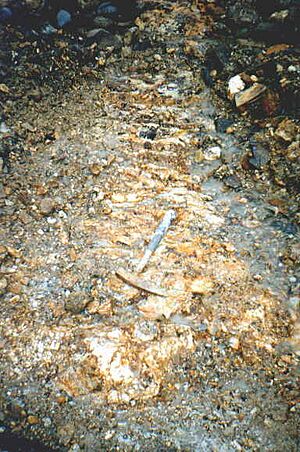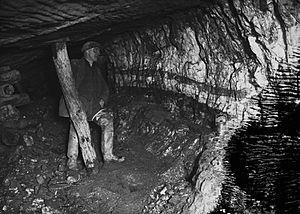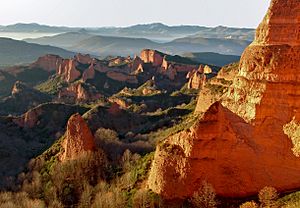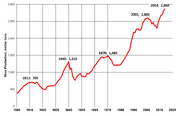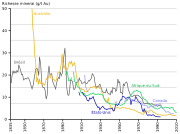Gold mining facts for kids
Gold mining is how people dig up gold from the ground. For a long time, people found gold in rivers and streams. They used simple tools like pans to separate the gold from sand and gravel. As people looked for more gold, they started digging deeper into the Earth. This led to bigger mining methods like open pits and using chemicals to get gold from rocks. Today, large companies do most of the gold mining. But millions of smaller miners also work in many parts of the world, especially where rules are less strict.
Just like any type of mining, gold mining can cause problems. These problems include issues with human rights and harm to the environment. In smaller mines, where there are fewer rules, workers face more dangers and risks to their health.
History of Gold Mining
No one knows exactly when humans first started mining gold. But some of the oldest gold items ever found are from a place called the Varna Necropolis in Bulgaria. These items are about 7,000 years old. This shows that people were mining gold a very long time ago. Some experts also believe that a site in Georgia might be the oldest gold mine, dating back to 3,000 or 4,000 BC.
Ancient Gold Mining Methods
During the Bronze Age, many gold objects were made, especially in Ireland and Spain. The Romans were very good at mining gold. They used powerful methods like hydraulic mining. This involved using large amounts of water to wash away soil and rock. They did this to find gold in loose dirt and gravel, like at a place called Las Médulas in Spain.
The Roman government controlled the mines. Gold was very important for their money system. It was even a big reason why the Romans invaded Britain. They also invaded a place called Dacia (modern-day Romania) to get gold. The story of their battles is shown on Trajan's Column in Rome. Later, under Emperor Justinian, gold was mined in many areas, including the Balkans and Egypt.
Gold Mining in India
In India, gold was first mined in the Kolar Gold Fields over 2,000 years ago. People dug small pits to find it. Gold found in ancient cities like Harappa has been traced back to Kolar. This is because the gold from Kolar has a special mix of silver. During the Gupta period (around 5th century AD), miners dug down about 50 meters (164 feet). Over time, the mining grew bigger. Later, kings and the British continued to mine gold there. It is thought that Karnataka state in India has produced about 1,000 tons of gold in total.
Medieval and Modern Gold Rushes
During the Middle Ages, the biggest gold mine in Europe was in Hungary (now Kremnica in Slovakia). In the 1800s, many famous gold rushes happened around the world. These events caused huge numbers of miners to move to new places. Examples include the California Gold Rush in 1849 and the Klondike Gold Rush. The discovery of gold in Witwatersrand also led to the founding of South Africa.
In 1961, the Carlin Trend was found in Nevada, USA. Nevada is now one of the world's top gold-producing regions. Since the beginning of civilization, about 6.3 billion ounces (196,000 tons) of gold have been mined worldwide. Nevada has produced about 1.1% of that total.
As of 2020, China was the world's largest gold producer. They mined about 368 tons of gold that year. Russia was second, and Australia was third.
Gold Mining Statistics
Even though the amount of gold in rocks is decreasing, gold production is still going up. This is because of new industrial tools and methods. These new ways of mining, like hydrometallurgy, help extract more gold from the ore.
Impacts of Gold Mining
Gold mining can change the natural environment a lot. For example, in tropical forests, gold mining is causing more and more trees to be cut down. This happens along rivers and in wild areas that have many different kinds of plants and animals. Mining can also leave behind harmful chemicals like cyanide or mercury in water. These chemicals are very dangerous for people and wildlife, even in small amounts.
Working Towards Responsible Mining
Many groups are working to make gold mining more environmentally friendly. They want to encourage "clean" or "ethical" gold. The goal is for all companies that sell gold to follow rules that support sustainable mining. Campaigns like 'No Dirty Gold' explain that mining can be harmful. They push for the industry to clean up its act. These groups also ask people to buy gold that has been produced in a responsible way.
Human Rights Watch wrote a report in 2015 about some of the problems around the world. The report said that many children in the Philippines work in dangerous gold mines. They dig in unstable pits that could collapse. They also mine underwater or in rivers, using tubes to breathe. Some children even use mercury, a very poisonous metal, to process gold. This can cause serious health problems. Because of reports like this, many jewelers and industry groups are now working towards more sustainable gold. The World Jewellery Confederation says it is trying its best to create a "Sustainable and Responsible Jewellery Industry."
Fairtrade and Fairmined Gold
In 2011, "Fairtrade" and "Fairmined" gold certifications were launched in the United Kingdom. These are special labels that show gold has been mined in a fair and responsible way. The Fairmined label means that the gold was extracted safely and ethically.
The Fairtrade Standard for Gold was created in 2013. The Fairtrade Foundation now lists many companies that use and sell Fairtrade Certified Gold. In 2017, the Fairtrade Foundation even started a free course for people who sell gold jewelry.
Safety in Gold Mines
Noise Levels
In the United States, the Mine Safety and Health Administration (MSHA) sets rules for how much noise miners can be exposed to. The safe limit for noise is 90 dBA (decibels) over an 8-hour workday. If miners are exposed to noise levels of 85 dBA or more, they must join a hearing protection program.
Studies have looked at noise levels for gold mine workers. One study found that some gold miners were exposed to noise levels that were much higher than the MSHA limit. Workers who drive large trucks, operate loading machines, or use drills often have the highest noise exposure in gold mines.
See also
 In Spanish: Minería del oro para niños Gold rushes:
In Spanish: Minería del oro para niños Gold rushes:
- United States:
- Georgia Gold Rush (beginning 1828)
- California Gold Rush (1848–1855)
- Pike's Peak Gold Rush (1858–1860)
- Holcomb Valley gold rush (1860s)
- British Commonwealth:
- Australian gold rushes (1850s)
- Victorian Gold Rush (1851–1860s)
- Fraser Canyon Gold Rush (late 1850s), Canada
- Witwatersrand Gold Rush (1880s), South Africa
- Klondike Gold Rush (1896–1899), Canada
- Central Otago Gold Rush (1860s), New Zealand
- Australian gold rushes (1850s)


